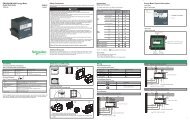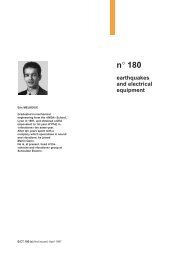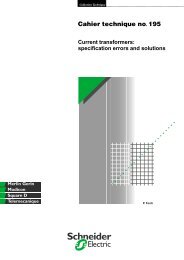Low Voltage circuit-breaker breaking techniques - Schneider Electric
Low Voltage circuit-breaker breaking techniques - Schneider Electric
Low Voltage circuit-breaker breaking techniques - Schneider Electric
- No tags were found...
You also want an ePaper? Increase the reach of your titles
YUMPU automatically turns print PDFs into web optimized ePapers that Google loves.
1 IntroductionThe energy sources for electrical installations areAC generators and transformers. All thesegenerators, however perfect, have an internalimpedance which has two major effects (seefig. 1 ).c in normal operating conditions, this impedancecauses voltage to drop from no-load condition tobring it to Un when the generator delivers In;c when a short-<strong>circuit</strong> occurs, this impedancelimits the current to a value, given in multiples ofIn.To take the example of transformers, their short<strong>circuit</strong>voltage Ucc (as a %) corresponds to theupper limit of their relative voltage drop underrated current, In.For example, an Icc of In/5%=20In is obtainedfor a short-<strong>circuit</strong> voltage of 5%, i.e. a current of29 kA for a 1000 kVA/400 V transformer. It is nothard to imagine the damage such a current couldcause in an installation (temperature rises andelectrodynamic forces are proportional to thecurrent square!).Thus, even if all precautions are taken to makesuch an occurrence unlikely, protective devicesare still needed to break the short-<strong>circuit</strong>currents.U = U 0 - Zi InU 0Un∆Un = Zi InoperationalcurrentInoverloadcurrentshort-<strong>circuit</strong> currentIccIFig. 1: incidence of internal impedance Zi of energy sources on voltage delivered and their maximum short-<strong>circuit</strong>currents.1.1 Definition of currents to breakKnowing the value of the current to break isnot enough to design a suitable <strong>breaking</strong>device !Current <strong>breaking</strong> is dependent on a number ofparameters relating to generators (a.c.generators or transformers), lines and loads:c an electric <strong>circuit</strong> is always inductive, and thusthe very fluctuations in the current to break,generate, as soon as the <strong>circuit</strong> is opened,negative current feedback which help maintainthe current. The value of this back-electromotivevoltage of the L di/dt type may be high whateverthe value of current i until this current iscancelled;c the resistive value of the <strong>circuit</strong> to break is ofassistance in <strong>breaking</strong> as long as the current isCahier Technique <strong>Schneider</strong> <strong>Electric</strong> no. 154 / p.4
















